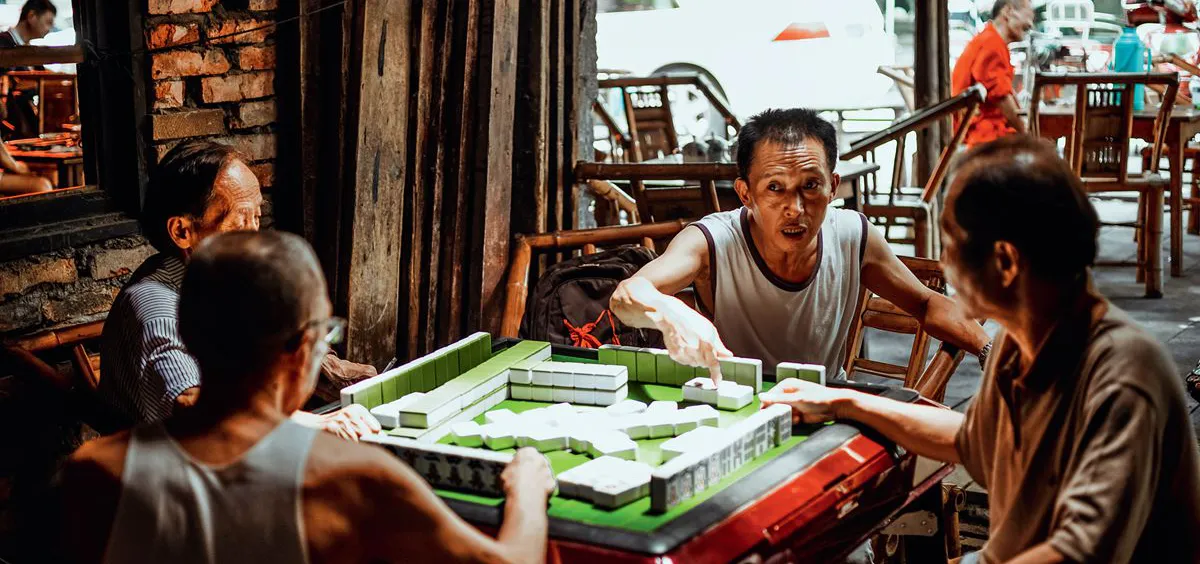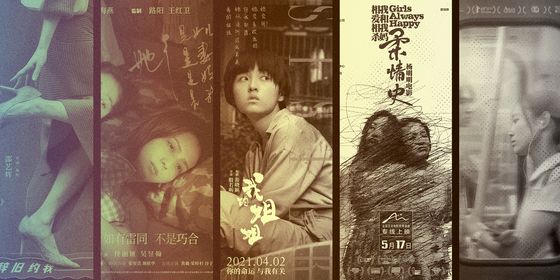Mahjong enthusiasts in China are trying to change perceptions of the ancient game, long associated with crime and gambling
For all of its history-making moments, the most discussed scene from 2018’s Crazy Rich Asians, hyped as the first Hollywood film in two decades with an all-Asian cast, unfolds inside a swanky mahjong parlor filled with strategizing seniors and clicking tiles.
There, the film’s protagonist, played by Constance Wu, confronts her antagonistic potential mother-in-law (Michelle Yeoh) over the traditional tabletop game, a scene that director Jon M. Chu says was deliberately choreographed to resemble a wuxia fight scene. “I wanted the sound of the tiles in this rhythm, this percussion that was sliding and hitting on the beats of this mental game as these two fierce women come head to head,” Chu told Vulture magazine, describing game-play as “fast,” “fierce,” “strategic,” and “smart.”
Half a century earlier, Mao Zedong had rhapsodized about the benefits of one of his lifelong hobbies. “Mahjong is a philosophy,” he claimed. “Through it, one understands the relationship between chance and inevitability; it’s also dialectical…even if you have the worst hand, as long as you are strategic and methodical, the inferior will become superior; weakness will become strength.”
Mao even claimed China had made “three great contributions to the world”: Traditional Chinese Medicine, Cao Xueqin’s Dream of the Red Mansions, and mahjong.

Women in the 1920s playing mahjong
Few find it similarly ode-worthy today, yet mahjong is definitely one of the most popular pastimes in the world with over 600 million players, most of them Chinese. Not everyone, though, is enamored with the fast-paced calling and shuffling of tiles. In spite of its long history, there are many critics of the game’s association with gambling, corruption, family feuds, and crime. One vocal naysayer is Liu Kuili, the vice-director of the Ministry of Culture’s intangible cultural heritage committee, who opposed a plan to include mahjong on the national heritage list in 2012.
Based on a set of 144 tiles engraved with characters and symbols, mahjong is ideally played by four players sitting around a square table. There are countless variations on the rules, depending on the region. Generally, though, all four players begin by receiving 13 tiles, then draw and discard more tiles in turns, until a legal hand is completed using a 14th drawn tile to form melds (a set of three identical ties or a three suited tiles in sequence) and eyes (two identical tiles).
“Most people around my age know how to play mahjong, though not everyone plays it frequently,” says Lai Chuntian, a 50-year-old teacher from Liaoning province, who has played regularly for 20 years. Lai can’t remember when she learned to play, but recalls the game’s constant presence in her childhood, when parents, relatives, and friends played in her family home. After enough watching, Lai “naturally learned how to play.”
As an adult, when some colleagues invited her to “play a few hands” after work, she agreed. That first game back in 1998 sparked her lifelong passion for mahjong. “Though the rules sound not very complicated, when you actually play, you will find that every game is different,” says Lai, explaining its attraction. “You need to calculate, evaluate the risk of every tile you discard, observe the facial expressions of your rivals, and remember their moves…I can’t think of a more interesting game.”
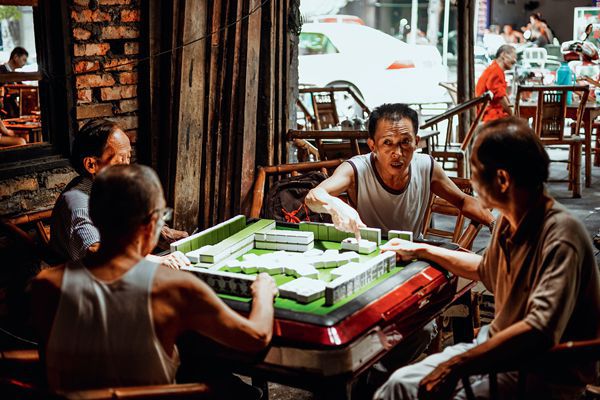
Mahjong played in a Sichuan teahouse
Also known as maque (麻雀, “Sparrow”), mahjong is believed to have been popularited sometime during the latter half of the 19th century. However, there are many different tales of its time and place of origin. Some trace it to the royal court; some credit its invention to Taiping Rebellion leader Hong Xiuquan during the Qing dynasty; others claim its creator was a man named Wan Bingtiao (万秉迢), inspired by the 108 characters from the Chinese classic Outlaws of the Marsh and who named the three suits after the three characters of his own name—characters (万), dots (饼, a homonym for 秉) and bamboo (条, a homonym for 迢).
All of these legends have supporters, but lack proof. In 2003, the then-president of the World Mahjong Organization (WMO) Yu Guangyuan offered a more widely accepted version that traced the game to Taicang, Jiangsu province, a granary in ancient China. In order to prevent the grain from being eaten, the government encouraged people to kill sparrows: Small bamboo signs, which could be exchanged for rewards, were distributed according to the number of birds killed, and people began to use the signs as currency for gambling.
Supporting this theory are many small details of mahjong, which can be associated with the hunting of sparrows. Among the three suits, the “dots” represent guns, or bullet holes; the “bamboos” refer to the sparrows; the pattern on the “One Bam” tile is a bird; and the “characters” are units of currency, symbolizing reward. As for the three “dragon tiles,” the Red Dragon is engraved with “中,” meaning a shot sparrow; the White Dragon symbolizes “empty,” or “shooting blanks;” and the Green Dragon, “发,” means “rewards.”
A 1893 paper by American anthropologist Stewart Cullin contains the first recorded mention of the game in the English-speaking world. There are many who theorize that mahjong was actually spread by sailors who traveled the Indian Ocean with Zheng He, the famous Ming dynasty eunuch-mariner, “but it’s just speculation; we still need archeological evidence,” Jiang Xuanqi, the secretary general of the WMO, tells TWOC.
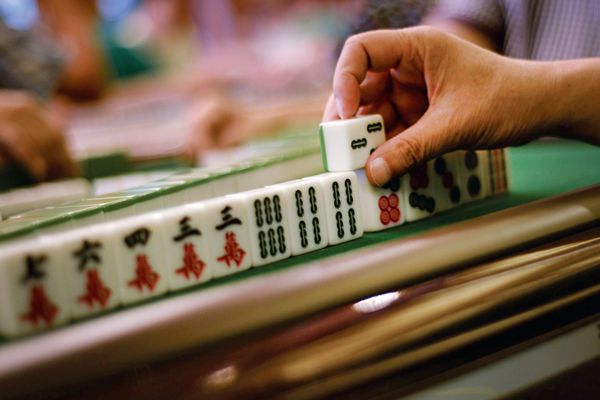
A player wins if a legal hand can be completed with the 14th tile
In 1920, writer Joseph Park Babcock, who learned how to play in China, wrote Rules of Mahjong, which simplified the system and promoted its skyrocketing popularity abroad. After studying in the US for many years, Chinese scholar Hu Shi wrote in his 1930 essay, “Mahjong,” that the game “has become a fad in the Western society. In gentlemen’s clubs, mahjong was placed on almost every table. In bookstores, there were many kinds of brochures about mahjong playing…overseas Chinese students could even make a living teaching it.”
In the meantime, Hu observed, the craze was growing even more out of control in China. “The increasing complexity of the game made it even more addictive, resulting in Chinese people, whether male or female, rich or poor, spending all their time on the 136 tiles, all year round,” wrote Hu, somewhat of a mahjong addict himself.
The editors of Opium, Gambling and Prostitution in Old Shanghai, published in 1990, wrote that during the early Republic of China, China’s most developed city saw nearly 20,000 people a day joining the mahjong tables in Shanghai’s 1,500 brothels and casinos. Multiplied across the country, this was a cause for concern. “[Assuming there are] a million mahjong tables in China, then even if everyone only plays eight rounds, that adds up to four million hours, which is 167,000 days wasted. Not mention the money won or lost, and the waste of energy,” fretted Hu.
Under the PRC—Chairman Mao’s admiration notwithstanding—mahjong was banned, together with other forms of gambling that were believed to represent capitalist corruption. “In the past, I used to see mahjong as something evil, something to do with feudalism, capitalism, and revisionism,” recalls Jiang, who lived through those oppressive years.
In 1985, when it became legal to play mahjong again, the Bureau of Public Security issued a document stating, “Though mahjong and cards are likely to be used for gambling, they are also traditional forms of entertainment…We should strictly forbid gambling, but not necessarily ban mahjong and cards.”

A startup in Chengdu teaching foreigners to play mahjong
Even after its legalization, the game continues to see occasional crackdowns, especially at the local level. In 2017, Wuhan became the first Chinese city to clarify its definition of “mahjong as leisure”—that is, games between family and friends, with 10 participants or less, and bets of less than 1,000 RMB per head—and “mahjong as illicit gambling,” which could be punished by up to 15 days of detainment. In the past years, mahjong parlors in places like Shenzhen and Jiangxi province have been ordered to close in the name of public security.
The decades-long ban and subsequent crackdowns has left a stigma on mahjong, which Jiang believes is unfair. “Gambling is people’s problem, not the tiles’,” Jiang argues. “Should we ban football or basketball games because people also bet on them?” Since 2006, Jiang has been trying to apply for National Intangible Cultural Heritage protection for the game. After the failed 2012 attempt, he told reporters that he wants to “vindicate the name of mahjong.”
Mahjong fans have been working since the 1990s to change mahjong’s perception by standardizing the game rules. In 1998, the China State Sports Commission published a new set of rules, normally referred to as “Guobiao” (Chinese standard) Mahjong, which laid out the three basic principles for playing—no gambling, no drinking, and no smoking.
In 2006, the WMO was founded in Beijing. The following year, the first World Mahjong Championship was hosted in Chengdu, attended by 144 participants from all over the world. Over the past 10 years, the organization has continued to promote mahjong as an intellectual sport internationally. They are now preparing for the upcoming sixth tournament in Italy next year.
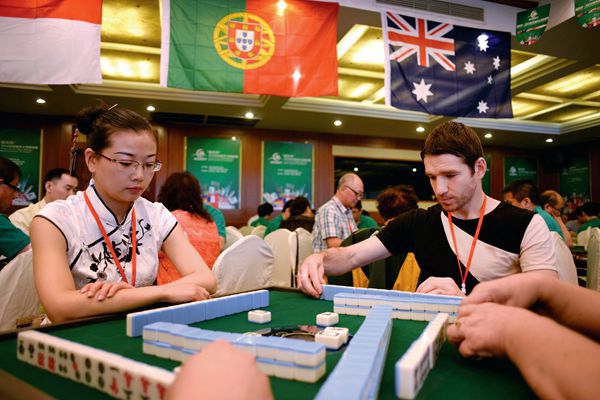
The 2014 World Mahjong Masters Tournament held in Kunming, Yunnan province
Outside the international spotlight, the game also has legions of ordinary supporters all around China. “I never feel like we are gambling,” says He Min, a retiree who has been running her own mahjong parlor in Liaoning province for two years. “Playing mahjong is just a way to spend one’s leisure time.” At He’s parlor, there are seven mahjong tables, all equipped with automatic tile-shuffling systems. She can count on having at least four or five tables occupied every day from 10 a.m. to 9 p.m.
Customers are mostly retirees, as well as a few who are self-employed and have “plenty of time to kill.” He, too, waxes on about the intellectual aspects of the game. “I believe it can protect people from Alzheimer’s disease. When you play mahjong, you exercise your brain and your arms.”
Ms. He earns more from the parlor than her old job, but doesn’t regard mahjong as a business. “It’s more like socializing. When you get old, you need to find something to entertain yourself,” she says, comparing the game to other retiree activities like square-dancing. She stipulates that this is certainly the case for Ms. Jin, a frequent customer in her late 70s, who gets dropped off by her son at the parlor every morning the morning and picked up in the afternoon. “Some people say playing mahjong is not a good hobby. But how else can she kill time during the day?” asks He. “Here, she can have someone to talk to.”
Referring to her customers as mayou, literally “mah mates,” He feels a special kind of camaraderie with them. She often personally cooks the free lunch that the parlor provides the players every day, and organizes a WeChat group for the frequent customers, from which “backup players” can be recruited if a table lacks one or two people.
In spite of its legalization, mahjong’s gray zone in the eyes of the authorities is worrisome to He. She has heard news of parlors shut down by the police for organizing gambling activities. “It basically depends how much money is involved,” explains He, who has consulted with local police inspectors. Supposedly, they assured her that if games involve less than 100 yuan, there won’t be a problem. “We don’t play ‘big’ here. Normally, even if you play all day, you won’t win or lose more than 100 kuai. It’s very rare someone loses hundreds per day,” says He.
But Lai points out that the danger is real. “Mahjong is definitely addictive. The longest time I ever played continuously was nearly 16 hours. It was exhausting, but I just couldn’t stop,” she recalls. “At that point, I couldn’t say that playing mahjong was healthy.”
Lai also repeats anecdotes of people who lost huge amounts of money and had to borrow repeatedly from friends. “But, can we just blame all of this on mahjong?” she asks. “It’s just a game. It’s the way you play it that’s right or wrong. It’s right to promote healthy lifestyle. But do you really think it’s smart to demonize such a popular game?”
Jiang tells TWOC that, aside from trying to achieve intangible cultural heritage status, the WMO is promoting mahjong as a cultural product abroad. “When foreigners learn to play mahjong, they will know the Chinese characters on the tiles, and use Chinese mahjong terminology,” he argues. “We believe mahjong is a medium to spread Chinese culture to foreign countries.”
At home, Jiang also hopes people can pay more attention to the core cultural value of mahjong, which he believes is intrinsically nobler than the current reputation of the game suggests. Jiang proudly recites “The Tenet and Spirit of Mahjong,” a 56-character doggerel: “Before playing mahjong, you must refine your character…do not be arrogant when you win, nor be petty when you lose…do not let emotions affect your voice and facial expressions; keep a broad mind and be generous…”
“This is what our ancestors left us through mahjong. It’s absolutely not unhealthy,” says Jiang.
Tales of the Tile is a story from our issue, “The Masculinity Issue.” To read the entire issue, become a subscriber and receive the full magazine.





